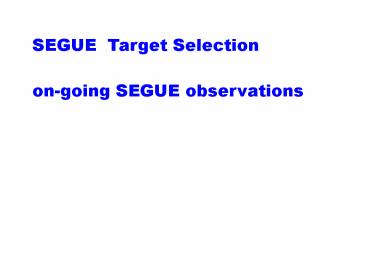SEGUE Target Selection - PowerPoint PPT Presentation
1 / 24
Title: SEGUE Target Selection
1
SEGUE Target Selection on-going SEGUE
observations
2
SDSS/SEGUE status as of Nov. 10, 2004 Black
completed stripe or plate pair 1002/3900 sq deg
imaging 25 complete, 34/400 plates 8.5
complete.
3
SEGUE Imaging Aug-Oct 2004 Aug 2004 1260 N 38
sq deg 291 N 104 Sep 2004 1100 N 105
1260 S 60 1100 S 107
72 S 117 72 N 62 Oct 2004 72
N 55 1300 N 52 1300 S 47
--------------------- 747 sq
deg earlier scans
255 --------------------- 1002 sq
deg 25 of SEGUE goal
Drillable imaging (filled Stripes NS) 1100
NS 200 sq. 1220 NS 175 sq. portions
of 72 NS 200 sq. 1300 NS
40 sq. Stripes 110072 were scanned in Aug/Sep
and targetted/drilled for Nov/Dec observing (6
week turnaround)
4
SEGUE imaging sample Color-Magnitude diagrams in
10 square degree boxes towards one direction on
the sky...
5
Dual turnoffs, indicates stream(s?) at 10 and 20
kpc from the sun.
Thick Disk Fs
Thin disk M stars
Halo or stream(s)?
Color-Magnitude (g-r,g) diagram for Strip 1260N
6
SEGUE spectroscopic sample Radial Velocities of
populations of similar stars, Metalicity, Teff,
log g determinations Kinematic, Chemical
population studies of the Milky Way and halo
7
Numbers indicate allocation of fibers by
spectral type per plate pair.
25 WD 150 A/BHB 200 F 375 G III V 150 Low
Metals 100 K III 100 K V 30 sdM (and L/T
candidates) 10 AGB 10 Cool Wds
SEGUE target selection currently has 11
categories, freshly reviewed, and aims to
observe a total of 240,000 stars arount the
sky. Samples of the stellar categories
8
SEGUE spectroscopy to date Aug 2004 8
Bright, 8 Faint Sep 2004 7 Bright, 6 Faint
Oct 2004 3 Bright, 2 Faint
---------------------------
18 B 16 F 34/400
Plates done 8.5 of SEGUE goal
43.6 plate equivalents To date we have approx.
16,000 classified spectra, grouped in these
categories (approximately) 1500 A/BHBs, 3000 F,
6000 G, 150 K giants, 1500 K dwarf, 300 WD, 800 M
dwarf, 2500 Low Metal candidates (F-K), plus
assorted QSOs and stars of unknown type.
9
White Dwarf
10
Cool White Dwarf Candidate
11
BHB Star, probe outer halo, streams to 150 kpc
12
F turnoff star, trace streams, halo, low Fe/H
to 20kpc
13
G dwarf, largest SEGUE sample, probe disk/inner
halo 1.5kpc to 8 kpc distances, Stream Giants
also here
14
-250 -200 -150 -100 -50 0 50
km/s
G dwarf Radial Velocity histograms, by Magnitude
(dist)
15
K Giants - probe halo to 200 kpc, total Mass of
MW,
16
K dwarf , kinematics from match to USNO-B,
RV photometric parallax probe disks from 0.5
2 kpc
17
Lower Metals than the lowest metalicity Globular
cluster!
Low metalicity candidate, Fe/H -2.6, g15.8,
g-r0.47 Pop III exploration, gradients in
inner/outer halo
18
M dwarfs, M,L,T dwarf candidates, M sub-dwarf
cands sample of halo M dwarfs vs. low-metal F's
19
AGB candidate, Giants in Sagittarius/Monoceros
streams? g 16.5,g-r 1.12, u-g 3.1, RV
-72km/s d(AGB) 18 kpc
20
K Giant Narrower lines, features less
deep. K dwarf Stronger features, broader l
ines.
How to tell a (distant) K giant from a (nearby) K
dwarf, using SDSS/SEGUE spectra.
21
Using the spectra to separate giants from
dwarfs, one can explore halo structure with K
giants.
Sun
SEGUE K giant stars used to probe halo to dgt 50
kpc
22
To test ability to determine metalicity of stars
from SDSS/SEGUE spectra, we obtain spectra of
objects with known Metals Fe/H -1.6
g
1 0 -1 Fe/H -2 -3
g-r
Target cluster stars separate well from field
stars, with spread of 1 sigma 0.25 dex.
Radial Velocity
23
With atmospheric parameters determined for stars,
one can go from observed 'color-magnitude' diagram
s to...
g
g-r
surface gravity
Physical Hertzsprung- Russell diagrams
Green cluster giants Red Field stars Yellow
Proper motion definite cluster matches
Teff
24
SEGUE is doing well with the grant of Fall season
observing during the last full year of
SDSS-I. This 2004 data is available to all SDSS
participants for analysis and papers.































